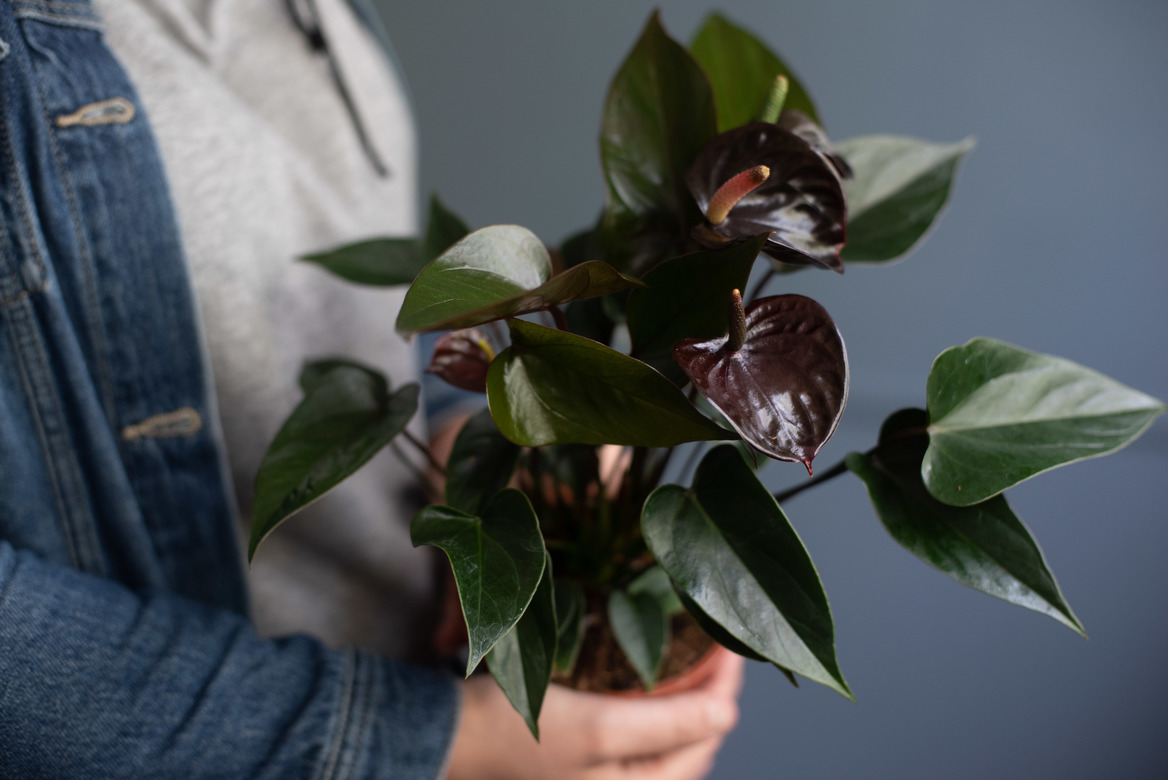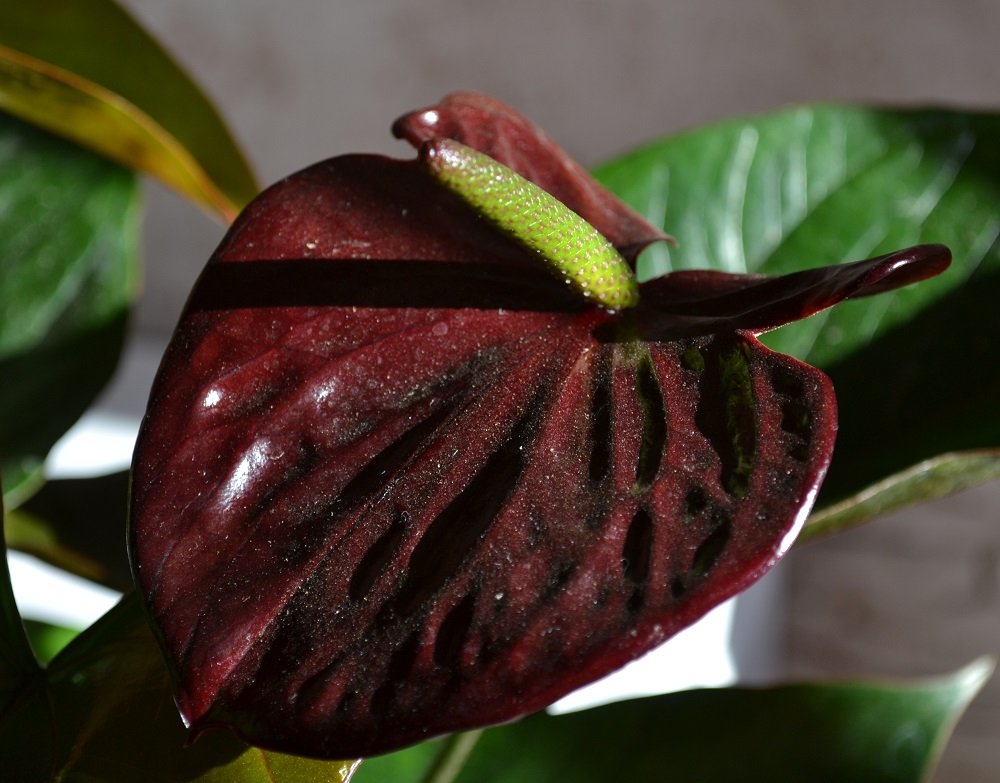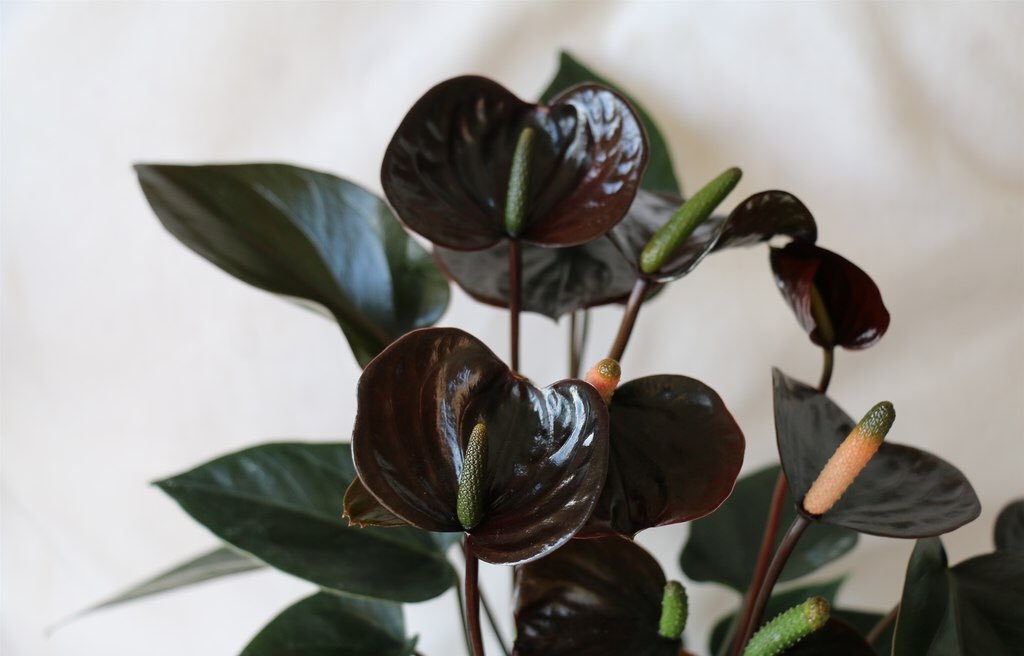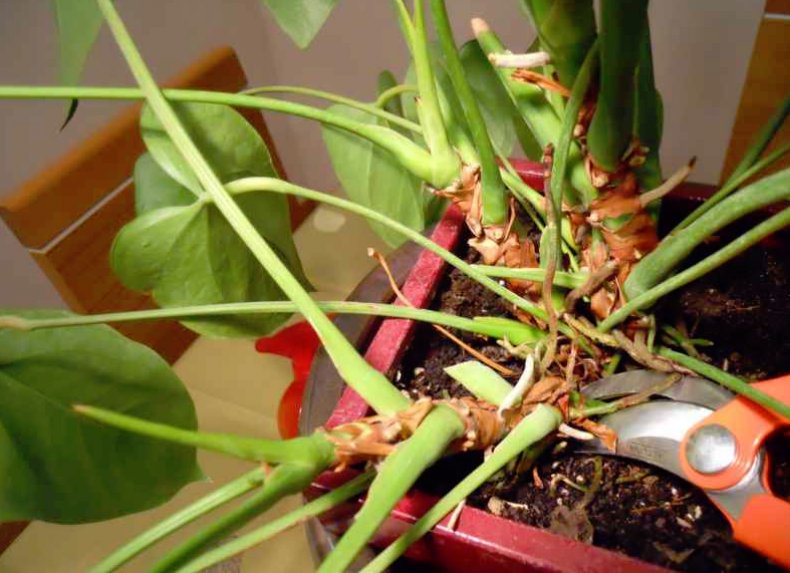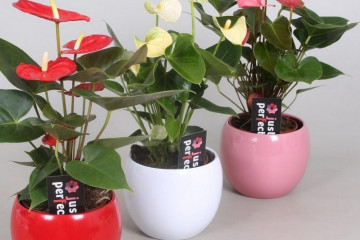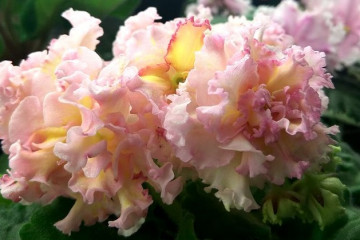Anthurium black - description and varieties
Content:
Anthurium black is one of the brightest and most beautiful representatives of its kind. It looks great at home when combined with other indoor plants. In order to grow anthurium in your apartment, you need to familiarize yourself with the conditions for planting and growing it.
What does black anthurium look like, description of varieties
Currently, there are several varieties of this decorative culture.
Most often, only some varieties are grown at home.
Anthurium Black Love
Black Love is a tall and branched shrub. It can grow up to 50 cm in height. Its leaves have a dark green tint, the buds are beige at the beginning of flowering, but over time they change color to almost black.
Therefore, it is very difficult to notice them against the background of a bedspread of a dark purple hue.
Anthurium Black Beauty (Black Beauty)
This anthurium species has flowers that are similar in shape to tulips. Its leaves are painted in a deep green color. Burgundy streaks are stretched along them.
With proper care, Black Beauty Anthurium can grow up to 65 cm in height. The buds, at the beginning of flowering, are black and burgundy, gradually change color to black.
Anthurium Black Queen
This variety has two equivalent names - Black Prince and Black Queen anthurium. This is the tallest member of the family. Very often it reaches a height of 80 cm. Its color changes from deep red to black. The ear of anthurium Black Queen has a light shade. Its leaves are heart-shaped, dark green in color.
Features of home care
In order for the plant to actively grow and bloom, it must be properly looked after. Anthuriums do well in pots, but at the same time, they are very demanding on growing conditions.
Temperature
Black anthurium is very fond of warmth. In the warm season, he needs to maintain the temperature at 20-25 ° C above zero. With the onset of cold weather, it is enough to keep warm in the room within 10-15 ° С. In such conditions, the plant tolerates winter favorably, and with the onset of warmth, it is again returned to optimal conditions.
Lighting
Do not expose the flower to direct sunlight - this can burn the leaves. If possible, it is better to place the bush on windowsills facing the east or west side.
If it turns out to put the pot only in the southern part of the house, then in the summer you need to create shading.
Watering and humidity
In the spring and during the flowering period, it is enough to water the plant several times a week. On very hot days, it must be additionally sprayed or placed next to a tray with water.Young flowers need to be moistened more often than adults, who need watering moisture when the top layer of the earth dries out. Pure water at room temperature is used for the procedure.
Soil and dressing
Anthurium requires sandy or loamy soil with sufficient water and air permeability. It makes no difference whether it will be bought in a store or made by yourself. To create a substrate at home you will need:
- charcoal;
- sand;
- leafy land;
- humus;
- pine bark;
- expanded clay or crushed stone for drainage;
- moss;
- humus.
All components are mixed in equal parts. Top dressing is necessary for the plant during the period of active growth and vegetation. Fertilizers promote active and lush flowering. Nutrients should be added no more than once a week. Top dressing is best applied to the soil in combination with spraying or watering. It is recommended to use mixtures containing nitrogen, phosphorus and potassium as fertilizers.
When and how black anthurium blooms
At home, anthurium rarely blooms. Even under ideal conditions, no more than 6 buds appear on it per year. Inflorescences begin to bloom in April and wither in late summer. The flower itself is an ear with a beautiful veil around it. It is important to remember that the age of a plant matters - the older it is, the more often flowers bloom on it and the larger they are.
Pruning
The shrub is cut only once a season - in the spring. The process is performed in the following sequence:
- Dried foliage is removed from the bottom of the bush.
- Withered buds are removed.
- Dried, diseased or rotten root areas are cut off.
- The upper part of the shoots is cut off.
Interesting! With proper care, cut shoots can grow into a new flower.
How black anthurium reproduces
At home, anthurium reproduces in three ways: by cuttings, dividing the bush and separating aerial roots.
To grow a flower using cuttings, you need to cut off the top of the stem. The stalk is treated with a solution to accelerate growth, after which it is placed in a container with peat. To create greenhouse conditions, the container with the seedling is covered with a film. With the appearance of the first leaves, the sprout can be transplanted into a pot.
The easiest way for flower growers is to divide the bush. This can be done every few years, since the root system of the plant is constantly growing. To carry out reproduction in this way, it is necessary to free the root system from the soil, divide it into parts, which are then planted in different containers.
Separation of aerial roots, unlike other methods, is the most difficult process of reproduction of Black Anthurium. The disadvantage is that a hybrid grown in this way most often loses the main characteristics of the mother bush. To perform the separation of aerial roots, it is necessary to soak the seeds in a weak solution of potassium permanganate. Then they can be germinated on a piece of gauze or foam rubber.
Transfer
The frequency of transplanting depends on the age of the plant. For a young bush, the procedure must be performed every year. Older anthurium is transplanted once every 3-4 years. It is recommended to do this in the spring in the following sequence:
- The pot is tilted to one side.
- The bush is carefully removed along with a clod of earth.
- Dry or diseased shoots are cut from the root system.
- A drainage layer is poured into a clean pot.
- The flower is lowered into a container and the roots are straightened.
- The soil is poured from above and slightly crushed.
Diseases and pests
Black anthurium rarely suffers from diseases and pests. However, some of them can seriously harm the plant.
Root rot can occur if the flower is not properly cared for. With a lack of light, heat, and also with waterlogging of the soil, anthurium can infect this type of fungal disease. When such a problem arises, the bush is cut off and transplanted into a new pot and soil.
If yellow spots appear on the leaves, then, most likely, the flower has been struck by anthracosis or septoria. In this case, it must be treated with fungicides.
Among insects, the most dangerous for anthurium are mealybugs, aphids, nematodes and mites. They must be driven out of the flowers. If measures are not taken in time, their actions can lead to the death of the plant. To prevent this from happening, the bush should be treated for preventive purposes with insecticides.
Black anthurium is an excellent option for decorating rooms. It blends well with other indoor plants and, with proper care, pleases the beauty of its large flowers with an ever-changing color.
